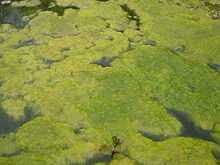Spirogyra
| Spirogyra | |
|---|---|
 | |
| Scientific classification | |
| Domain: | Eukaryote |
| (unranked): | Archaeplastida |
| Kingdom: | Protista |
| (unranked): | Streptophyta |
| Phylum: | Chlorophyta |
| Class: | Zygnematophyceae |
| Order: | Zygnematales |
| Family: | Zygnemataceae |
| Genus: | Spirogyra Link in C. G. Nees |
Spirogyra is a genus of filamentous green algae of the order Zygnematales, named for the helical or spiral arrangement of the chloroplasts that is diagnostic of the genus. It is commonly found in freshwater areas, and there are more than 400 species of Spirogyra in the world.[1] Spirogyra measures approximately 10 to 100μm in width and may stretch centimeters long.
General characteristics
Spirogyra is unbranched with cells connected end to end in long male reproductive system filaments. This genus of green algae undergoes a haploid-dominant life cycle. The cell wall has two layers: the outer wall is composed of pectin that dissolves in water to make the filament slimy to touch while the inner wall is of cellulose. The cytoplasm forms a thin lining between the cell wall and the large vacuole it surrounds. Chloroplasts are embedded in the peripheral cytoplasm; their numbers are variable (as few as one). The chloroplasts are ribbon shaped, serrated or scalloped, and spirally arranged, resulting in the prominent and characteristic green spiral on each filament. Each chloroplast contains several pyrenoids, centers for the production of starches, appearing as small round bodies.
Spirogyra is very common in relatively clean eutrophic water, developing slimy filamentous green masses. In spring Spirogyra grows under water, but when there is enough sunlight and warmth they produce large amounts of oxygen, adhering as bubbles between the tangled filaments. The filamentous masses come to the surface and become visible as slimy green mats. Mougeotia and Zygnema are often found tangled together.
Reproduction
Spirogyra can reproduce both sexually and rarely asexually. In vegetative reproduction, fragmentation takes place, and Spirogyra simply undergoes the intercalary mitosis to form new filaments.
Sexual Reproduction is of two types:
- Scalariform conjugation requires association of two different filaments lined side by side either partially or throughout their length. One cell each from opposite lined filaments emits tubular protuberances known as conjugation tubes, which elongate and fuse, to make a passage called the conjugation canal. The cytoplasm of the cell acting as the male travels through this tube and fuses with the female cytoplasm, and the gametes fuse to form a zygospore.
- In lateral conjugation, gametes are formed in a single filament. Two adjoining cells near the common transverse wall give out protuberances known as conjugation tubes, which further form the conjugation canal upon contact. The male cytoplasm migrates through the conjugation canal, fusing with the female. The rest of the process proceeds as in scalariform conjugation.
The essential difference is that scalariform conjugation occurs between two filaments and lateral conjugation occurs between two adjacent cells on the same filament.
Gallery
-

Spirogyra
-

More spirogyra
-

Single spirogyra cell
-

Another close-up of an individual spirogyra cell
-

Spirogyra. Each numbered tick = 122 µM
-

Spirogyra. Each numbered tick = 20 µM
-

Patch of spirogyra from algal blooming in Westfalian pond
-

Roumanian test image
References
| Wikimedia Commons has media related to Spirogyra. |
- Spirogyra at microscopy-uk.org.uk
- John Whitton, B.A. and Brook, A.J. (editors) 2002. The Freshwater Algal Flora of the British Isles. Cambridge University Press, Cambridge. ISBN 0-521-77051-3.